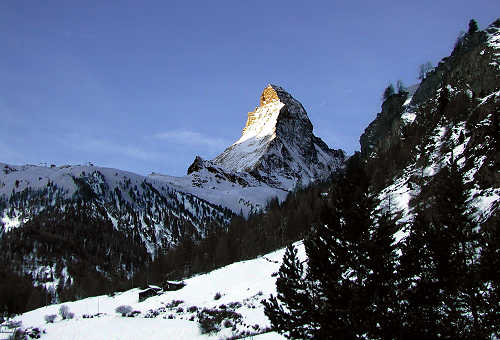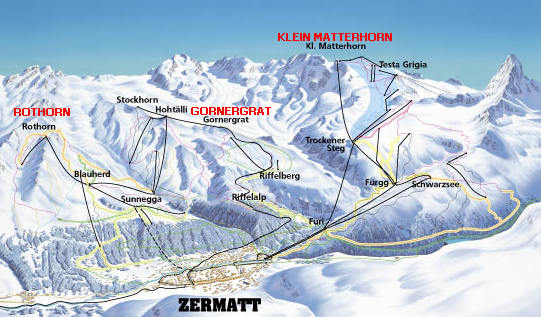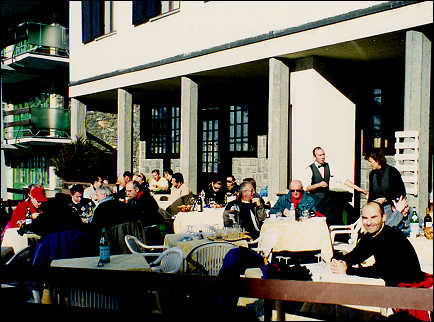

| Skiing in Zermatt is a very different experience from that of skiing
in the USA, particularly if you ski in the north-east. The wide open
spaces can appear somewhat intimidating at first, as most of the skiing
is above tree-line, until one realises that almost nobody seems to ski
off-piste (off trail). Many skiers do not even ski off the edges
of the groomed trails when there has been fresh snow. Indeed, after
a snowfall we were able to find fresh untracked powder for a couple of
days. Furthermore, the only people on the slopes whilst heavy snow
was falling all seemed to be visitors, which could be explained by the
fact that some locals informed us the skiing would be bad because visibility
would be poor.
Zermatt is effectively split into two different areas, both physically
and because of the lift system. Rothorn and Gornergrat forming one
and the slopes off the Klein Matterhorn the other. However, it is
possible to ski between the two, though this is by no means made easy.
This review will concentrate on the Rothorn and Gornergrat areas as this
is where we spent most of our time skiing so far.
 On the Rothorn and Gornergrat side there are two main methods of getting up to the skiing. The quickest (though usually crowded) is by the Alpen-Metro (funicular) to Sunnegga station which connects nicely into the lift network. Secondly, one can take the cog-train which is rather slow, though it is a must on a clear day for its beautiful views. Alternatively, go up by the Alpen-Metro and take a leisurely trip down on the train at the end of a long day.
From Gornergrat, where the cog-train terminates, one can head up the
mountain to Hohthalli and Stockhorn for some more advanced skiing.
We liked 8b down from Hohtalli as this allowed us to link with Gant (9c)
or to ski over to Riffelalp (9b) and the train up or down. Trail
8b also had some good terrain off-piste which had good snow almost all
the time we were in Zermatt, partly due to the fact mentioned above, that
so few people seem to ski off the groomed runs. For those in search
of powder but not yet ready for the steep and deep, the beginner terrain
from Rotenboden down to Riffelberg (especially near K2 T-bar) provided
some really nice powder that was hardly skied. Yet it was not too
deep or steep for those in the party who were new to powder.
 Whilst staying in Zermatt and hearing that Italy was but a short trek (we were told that Cervina was a thirteen kilometer ski), Kenny and I decided to ski across our first international border. We picked a beautiful sunny Saturday morning for our adventure, heading out of the door of the hotel at the European early morning time of 10:30am. We walked the short distance to the bus stop and waited for a bus to take us to the lifts serving the Klein Matterhorn. The buses are regular, with one coming along every ten minutes or so. As this is the alpine equivalent of rush hour, the bus was fairly full though we had no problem getting on board. This last point was brought home to us when we lined up for a good twenty minutes for tickets (tickets for the Italian side can be included in the Zermatt pass). The ride to the Klein Matterhorn takes about forty-five minutes and involves at least one change (depending on which lifts are running). The tram, up the final leg to the Klein Matterhorn, actually enters the face of the mountain near the top, and the exit is via a tunnel cut through the mountain itself. From here it is a short ski down (intermediate trail) to the border which we arrived at around noon. Once into Italy there are several routes down to Cervina. The upper slopes were fairly busy and we felt a little intimidated by the number of skiers and riders. However, most people did not seem interested in skiing all the way down to Cervina and the slopes got less crowded the further down we went. Skiing down took us about thirty minutes almost all intermediate or beginner trails). After a couple of runs from the village of Cervina we decided to stop for pizza and a drink, we were in Italy after all. We sat in the sun for an hour and then decided to head back over to Switzerland.  The ride up from Cervina took about thirty minutes as it is a much shorter journey than that on the Swiss side. Upon arriving back in Switzerland, we chose to ski down to Trockener Steg and take the tram down. The lower slopes can get crowded and a little icy. The whole trip, including lunch lasted around five and a half hours. I would not advise beginner skiers to try this trip as it is largely over intermediate terrain and the round trip is close to twenty-six kilometers (16 miles). Intermediate skiers should have few problems, though I do recommend bringing something to drink, sunscreen and an extra layer as it could easily be a long day. Furthermore, please check conditions before leaving as it can get very windy on the Klein Matterhorn and if the weather changes, it could well be a tricky ski back. Overall, I thoroughly recommend skiing over to Italy, it is a different type of ski resort with a nice mix of terrain and makes a pleasant contrast to Zermatt. |
|
There are a number of places in town that rent boots and skis, and prices
were pretty uniform with a good variety of differing brands to try.
A damage waiver seemed to be included at all places (10% extra), though
please check this. We had only one German and French speaker in our
group, but this was not a problem as most of the staff spoke English.
We found the ski boot selections much higher in quality than those available
for rental in the U.S.
Bayard Top Equipment
was the other store we used to rent equipment. It was the only place
in Zermatt which offered both telemark and alpine skis for rental.
One member of our group is a telemarker, so this was an important point.
Kara and I highly recommend if you come to Zermatt, that you pop by
Bayard and try the hand-made Stockli skis too. Visit the Bayard website
by taking this LINK.
Nick was born in the UK and has spent several years living and skiing in Vermont, USA. He and his wife Kara were both children's ski instructors at Smuggs. |

